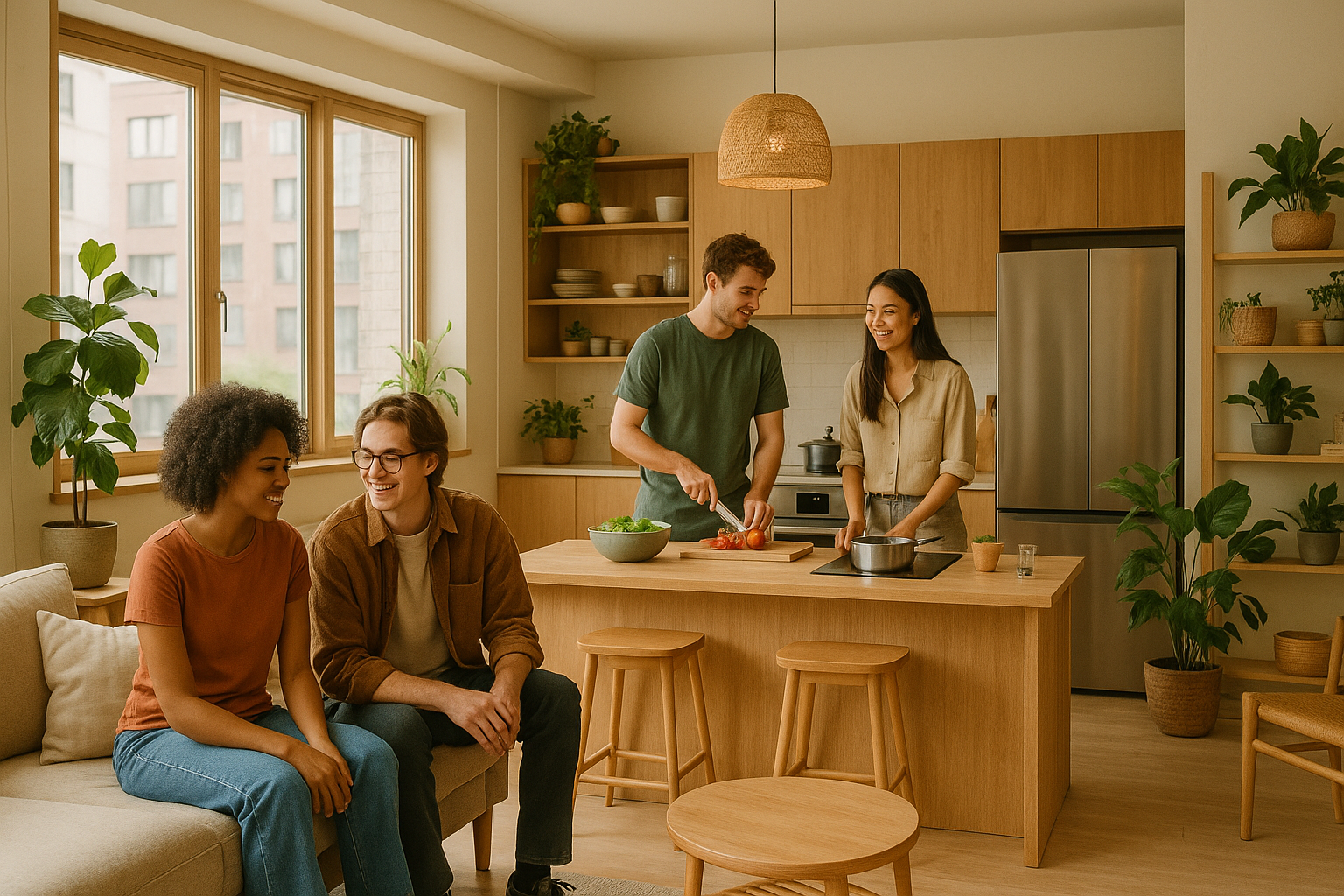Coliving in 2025 is redefining urban housing by offering affordable, eco-friendly, and community-driven living options. This model combines private spaces with shared amenities, reducing housing costs by 30% and cutting residents' environmental footprint by 23%. It also addresses social isolation, with some communities reporting a 64% drop in loneliness.
Key Highlights:
- Market Growth: Global coliving market growing at 27.17% CAGR (2023–2030).
- Living Formats: Options include work-live spaces, short-term stays for digital nomads, and long-term housing with community hubs.
- Technology & Sustainability: Smart systems like keyless entry and energy management, plus eco-friendly designs.
- Social Impact: Builds connections through shared spaces and activities.
Whether you're a remote worker, urban professional, or digital nomad, coliving offers cost savings, flexibility, and community in one package. Learn how this trend is shaping housing in 2025.
Market Size and Growth
The coliving market has seen rapid expansion, fueled by changing housing preferences and economic influences. Globally, the market is projected to grow at a compound annual growth rate (CAGR) of 27.17% from 2023 to 2030[1].
2025 Market Statistics
Urban hubs like New York City, San Francisco, and Austin remain at the forefront of the co-living movement. These cities attract diverse groups - students, young professionals, and digital nomads - who are drawn to the shared living model. This growing interest highlights the factors driving the market's current momentum.
Growth Factors
The rise of remote work has played a major role in the popularity of co-living spaces. With hybrid work becoming more common, new concepts that merge living and working environments are gaining traction. Additionally, many developments now include wellness-focused amenities like fitness centers, yoga studios, and mental health services, broadening their appeal. On top of these lifestyle perks, co-living also stands out for its economic advantages over traditional housing options.
Cost Comparison Guide
Co-living offers a cost-efficient solution by bundling services like utilities, high-speed internet, and cleaning into a single fee. This makes it an attractive option for those seeking an affordable lifestyle in high-cost urban areas.
The ongoing growth of the co-living market reflects a societal shift toward more flexible and community-oriented living arrangements.
New Coliving Formats
Coliving has expanded to include a variety of housing solutions tailored to specific lifestyles and preferences. These formats highlight the shifting priorities around work, mobility, and community in 2025. As the market grows, these options show how coliving continues to meet changing professional and personal needs.
Work-Live Spaces
Work-live spaces are designed for remote professionals, blending work and home seamlessly. They feature coworking areas, fast internet, and essential tools for productivity.
For example, Coconat, near Berlin, offers a "workation" setup where residents can focus on projects in a peaceful, natural environment. It combines private workspaces with shared areas, promoting both productivity and social interaction.
Another example is Sun & Co. in Javea, Spain, which accommodates up to 20 remote workers. Their model focuses on professional and personal growth, offering:
| Feature | Purpose | Benefit |
|---|---|---|
| Workspaces | Focused productivity | Fully equipped areas for efficient work |
| Workshops | Skill development | Opportunities for learning and sharing |
| Outdoor Activities | Work-life balance | Builds connections through shared fun |
| High-speed Internet | Reliable connectivity | Supports uninterrupted remote work |
These setups go beyond just work, offering a lifestyle that balances career demands with community and leisure.
Short-Term Living Options
Short-term coliving is ideal for digital nomads and mobile professionals who need flexibility and a sense of community. Stays can range from a few weeks to several months.
Take Arctic Coworking Lodge in Norway’s Lofoten Islands, for instance. It provides 10 workstations and meeting rooms alongside outdoor adventures like hiking and surfing, blending productivity with exploration.
Long-Term Housing Models
Long-term coliving focuses on fostering deeper community ties and environmentally conscious living. These setups combine permanent residences with shared amenities and sustainable practices.
PortusHome in Vászoly, Hungary, is a great example. It offers permanent living spaces in a rural setting, complete with community hubs. This shows that coliving isn’t just for urban areas - it works in quieter, countryside locations too.
As coliving continues to develop, these formats are likely to evolve, offering even more features to enhance both community connections and individual comfort.
Tech and Green Features
Modern coliving spaces combine smart technology with eco-conscious practices to create efficient, secure, and environmentally friendly living environments.
Smart Building Systems
Digital platforms in coliving spaces offer a range of features aimed at convenience and efficiency:
| Management Feature | Function | Resident Benefit |
|---|---|---|
| Access Control | Mobile app–based entry | Keyless entry and improved security |
| Energy Management | Automated temperature control | Lower energy bills and better comfort |
| Resource Booking | Digital scheduling system | Easy access to amenities and tracking |
| Community Engagement | Resident portal for communication | Instant updates and event participation |
These systems align with modern living standards, paving the way for buildings that are both tech-integrated and environmentally conscious.
Green Building Standards
Coliving spaces designed with green standards help reduce the environmental impact of residents by 23% compared to traditional housing. This is achieved through features like air filtration, water-saving systems, natural light optimization, and the use of sustainable materials.
"operators that survive the pandemic will emerge with stronger and more financially sound business models. These will rely on fundamentals rather than magical valuation methodologies" – Connor Moore
Standards such as WELL ensure that these spaces include:
- Air quality monitoring and filtration systems
- Water-saving technologies
- Maximized use of natural light
- Sustainable building materials
- Programs that promote community well-being
These efforts not only benefit the planet but also contribute to healthier and more enjoyable living conditions.
Tech Features List
Here’s a closer look at the tech features found in modern coliving spaces:
| Feature | Description | Benefit |
|---|---|---|
| Wireless Door Locks | App-based access control | Greater security and convenience |
| Doorbell Cameras | Remote video and audio communication | Easier package management |
| Home Security Cameras | Surveillance for shared areas | Discourages theft and ensures safety |
| Smart Thermostats | Energy-efficient temperature control | Lower bills and better comfort |
| Low Electricity Bulbs | Energy-saving lighting | Reduced environmental impact |
These combined technologies and eco-friendly practices show how modern coliving spaces are designed to enhance residents' lifestyles while minimizing their environmental footprint.
Social and Lifestyle Impact
Coliving spaces are changing how people in cities form connections and navigate urban life in 2025. These modern setups combine thoughtfully designed shared spaces with digital tools to create vibrant communities. By integrating smart features with a focus on communal living, coliving strengthens social ties while promoting a more connected lifestyle.
Building Social Connections
Coliving spaces are designed to bring people together through shared spaces and organized activities. One resident shares their experience:
"The people are incredibly kind and the owner and staff do everything they can to make sure everyone feels a part of a special community. And I certainly felt that warmth - I made friends instantly and truly enjoyed every moment." - Angela G., Coliving.com Reviewer
These spaces don’t just foster friendships - they also make urban living more manageable.
City Living Solutions
Coliving offers a balance between social interaction and personal privacy. With inclusive pricing models, residents can enjoy affordable living without sacrificing their personal space.
Online Platform Benefits
Digital platforms complement the physical community experience, making it easier for residents to connect. Coliving.com, active in over 360 cities across 70+ countries, plays a key role in this shift. One resident explains:
"It felt like a community where everyone knew each other, and I was able to form some meaningful friendships during my stay. The events organized by the host were engaging and added to the experience." - Romane F., Coliving.com Review
The platform’s impact is highlighted by these numbers:
| Feature | Details |
|---|---|
| Verified Reviews | 14,000+ reviews with a 4.9/5 average rating |
| Global Reach | 100,000+ active community members |
| Available Spaces | 37,000 rooms across 1,800 coliving spaces |
| Community Types | Tailored spaces for remote workers, students, and professionals |
These tools help residents find communities that match their lifestyle, making coliving a practical and enjoyable choice for long-term urban living.
Guide for Future Residents
This guide offers practical advice to help future residents choose the right coliving space, based on trends and advancements discussed earlier.
Basic Features Guide
Modern coliving spaces often provide savings of up to 40% compared to traditional studio apartments. These spaces typically include all-inclusive pricing that covers essentials like furnished rooms, utilities, high-speed Wi‑Fi, flexible leases, streaming services, and access to shared community perks like social events and lounges.
| Core Features | Community Perks | Additional Amenities |
|---|---|---|
| Furnished rooms | Regular social events | Workspace areas |
| Utilities included | Networking opportunities | Cleaning services |
| High-speed Wi‑Fi | Shared lounges | Kitchen essentials |
| Flexible leases | Community managers | Laundry facilities |
| Streaming services | Activity programs | Rooftop spaces |
Space Selection Tips
Once you’ve identified the key amenities, consider these practical factors to narrow down your options:
-
Location Assessment
Evaluate the neighborhood for safety, proximity to work, favorite spots, public transit, restaurants, and essential services. -
Community Fit
Look into the resident demographics and the types of community activities offered. Dorothée B., a past resident, shared her thoughts:"I stayed for a month at this coliving space and my experience was amazing! Juan and Cata, along with the other residents, made me feel at home from the first day. It's a truly magical place with positive and peaceful energy. Everything is very clean, and you can tell it was created with lots of love."
-
Practical Considerations
Check for potential noise issues, especially in street-facing rooms. Confirm workspace availability and ensure its usage aligns with your schedule.
Using Coliving.com
For an easier search process, Coliving.com provides helpful tools and in-depth information. The platform emphasizes affordability and community-focused living, making it a great resource for finding the perfect space.
| Feature | Details |
|---|---|
| Starting Price | From $100/month |
| Coverage | 65+ countries |
| Available Rooms | 37,000 options |
| Support | 24/7 customer assistance |
| Booking Protection | Money-back guarantee |
Tonette J., another recent resident, highlighted the experience:
"I had a wonderful experience staying here for a month! The workspace and shared spaces were fantastic, including the rooftop, and my private area was just as impressive. The whole atmosphere made it easy to both work and relax, creating a perfect balance."
Use the platform’s filters to customize your search based on your lifestyle, whether you’re working remotely, studying, or pursuing professional goals. With over 14,000 verified reviews averaging a 4.9/5 rating, you can trust the platform to provide transparent and reliable options.
Looking Ahead
Main Trends Summary
Coliving is evolving quickly, driven by changes in lifestyles and economic challenges. Research highlights its cost-saving and eco-friendly benefits, making it a promising housing option for the future.
Three key developments are shaping the industry's direction:
| Trend Category | Current Impact | 2025 Projection |
|---|---|---|
| Market Growth | Expanding post-pandemic recovery | Stronger focus on core business fundamentals |
| Sustainability | 23% lower carbon footprint | Adoption of WELL Building Standards |
| Community Design | Tackling urban loneliness | Better frameworks for social connections |
These shifts are influencing how people choose housing and impacting their overall quality of life.
Impact on Housing Choices
Coliving is changing how people think about housing by combining affordability, community, and eco-conscious living. For example, MyTown has shown how thoughtful coliving designs can reduce urban isolation while encouraging greener lifestyles.
"Operators that survive the pandemic will emerge with stronger and more financially sound business models. These will rely on fundamentals rather than magical valuation methodologies." – Connor Moore
This approach is especially appealing to urban professionals looking for affordable housing that also fosters connection. By incorporating smart building systems and sustainable features, coliving spaces are becoming a top choice for those who care about the environment. These communities prove that shared living can balance social interaction with eco-responsibility, with emissions reportedly at just one-third of the average UK household.
FAQs
How does coliving help reduce social isolation and loneliness in cities?
Coliving creates a built-in community that helps reduce social isolation and loneliness, especially in busy urban settings. By offering shared spaces like kitchens, lounges, and coworking areas, coliving encourages organic interactions and meaningful connections among residents.
Many coliving spaces also host events, workshops, and group activities, fostering a sense of belonging and support. This environment makes it easier for people to build friendships, collaborate, and feel part of a community, addressing the challenges of loneliness often associated with city living.
What eco-friendly and tech-savvy features set coliving spaces apart from traditional housing?
Coliving spaces stand out for their focus on sustainability and technology, making them a greener alternative to traditional housing. By emphasizing shared resources, these spaces reduce waste and energy consumption. For example, residents often share kitchens, living areas, and appliances, which minimizes the need for redundant resources.
Many coliving spaces also integrate smart technology like energy-efficient lighting, temperature controls, and water-saving systems to promote sustainable living. Additionally, their centralized urban locations encourage walking, biking, or using public transportation, further reducing environmental impact. These thoughtful features make coliving a forward-thinking choice for eco-conscious individuals.
What should I look for in a coliving space to match my lifestyle and work needs?
When selecting a coliving space, think about how well it supports your lifestyle and professional goals. Look for spaces that foster a strong sense of community through social events or shared activities, as this can enhance your overall experience.
Consider practical features like flexible lease terms, included services such as cleaning, and access to shared amenities like coworking spaces or fitness centers. If remote work is part of your routine, ensure the space offers reliable high-speed internet and quiet work areas. Finally, think about whether the community aligns with your values, such as sustainability or cultural diversity, to ensure it feels like home.
























